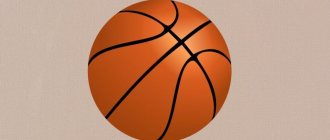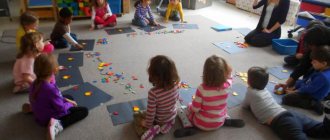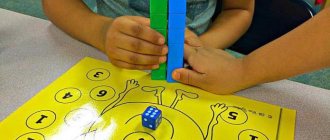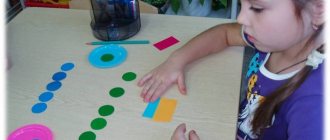Cuisenaire's technique: advantages
Cuisenaire's technique is universal; it does not conflict with any of the existing techniques, but, on the contrary, successfully complements them.
Cuisenaire sticks are simple and understandable to children: they get used to them at a very early age and already perceive them as playing material, and do not see them as boring memorization of numbers.
In addition to the obvious effectiveness of teaching the technique, Cuisenaire's rods also involve a number of border areas: they develop fine motor skills, visual and spatial perception, stimulate the imagination, and teach order.
Cuisenaire rods and language learning
Cuisenaire rods are widely popular as teaching materials for teaching mathematics. But their role in language learning is also very great. Abroad, sticks are actively used in English lessons; they help highlight unstressed and stressed syllables and emphasize rhythms. This technology can be successfully applied in our native language, Russian.
This is how we show the stress and divide the syllables accordingly - a very popular technique for teaching reading, which you may have seen before in our alphabet books:
Cuisenaire rods provide a clear illustration for comparative adjectives.
The second stage of working with Cuisenaire rods: mathematical
The second stage of working with sticks is mathematical. Children literally learn to “feel” numbers, that is, learning takes place not through abstract concepts, which are still very vague for children, but through practice.
Cuisenaire sticks will help you master fractional numbers. For example, take a brown stick representing the number 4. How many red sticks fit into it and, accordingly, what part is the red stick from the brown one?
It's 2/4
How many green sticks fit into a brown stick and what part does the green stick make up of the whole? It's 3/4
It's 9/10
Cuisenaire rods are a simple “calling card” of the multiplication table. Let's start with a white stick representing the number one. If you take it in the singular, you get the number one. If you take ten white sticks, you get the number 10, which you need to check with the “right stick.”
Other examples of tasks at the second stage:
- Take several white sticks and move them close together in a row. Find an analogue in the set.
- You name the number and the child finds a stick of the corresponding color. At first, the numbers can be called in order, but then the task becomes more complicated, the numbers come apart.
- Take the shortest stick. What color is it? The white stick is a unit, the number “one”.
- For a colored stick, you need to match its analogue, shown on the card in the form of a number.
How to make Cuisenaire sticks with your own hands
Of course, it is easier to purchase a ready-made set, but parents do not always have this opportunity. Then the question arises: is it possible to create such a pedagogical miracle on your own? In fact, making the same sticks will be problematic due to the fact that they are voluminous and will have to be shaped using carpentry tools. But making a flat, simple analogue of 116 parts is not difficult.
To work you will need:
- 10 sheets of colored cardboard. Pay attention to the fact that the sheets are dense, otherwise all efforts will be in vain, and the manufactured parts will be wrinkled after the first use. Shades must correspond to the color scheme provided by the methodology;
- sharp scissors;
- a ruler at least 20 cm long;
- a simple pencil, preferably with a hard lead, so that marks left on paper are easier to remove;
- glue stick;
- small box or bag.
Method of manufacturing developmental material
| View | Color | Length | Number | Qty |
| White family | White | 1 | One | 25 pcs. |
| Red family (multiples of two) | Pink | 2 | Two | 20 pcs. |
| Red | 4 | Four | 12 pcs. | |
| Burgundy | 8 | Eight | 7 pcs. | |
| Blue family (multiples of three) | Blue | 3 | Three | 16 pcs. |
| Violet | 6 | Six | 9 pcs. | |
| Blue | 9 | Nine | 5 pieces. | |
| Yellow family (multiples of five) | Yellow | 5 | Five | 10 pieces. |
| Orange | 10 | Ten | 4 things. | |
| Black family (in multiples of seven) | Black | 7 | Seven | 8 pcs. |
- Before you start working directly, you need to get acquainted with the properties of the blocks, and then transfer them to flat figures. This will help avoid future mistakes in counting the number of sticks of a certain color that need to be made in tasks.
- Take the sheets and carefully mark them, using a ruler and pencil to draw the required number of stripes. You should get rectangles 2 cm wide and 2 to 20 cm long (the strips are folded in half).
- Using scissors, cut the resulting strips along the contour, being careful not to accidentally cut off the length.
- Use an eraser to erase any remaining pencil marks so as not to spoil the appearance of the set.
- Bend the strips exactly in the middle and glue them together.
- Place the parts in a prepared box or bag.
Important: teachers remind you that this kind of implementation is easier to perform, but with flat parts many games become impossible, so you should try to cut out three-dimensional parts or purchase a ready-made set of Cuisenaire sticks.
Dear parents! Practice has proven more than once that a child who is not accustomed to think logically and abstractly from infancy will subsequently no longer be able to learn to do this at the direction of a teacher. Take the time to practice, and the results will not be long in coming.







